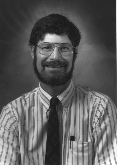|
Vol. 4, No. 3, May/June 1996 |
Subscribe to AT Messenger Download PDF Viewer |
| PDF
Version (for printing) Large Print (pdf) Text Version |
HomeGrown in Delaware
 This column spotlights the AT movers and shakers we have right in our own
backyard. Dick Lytton, the Coordinator of the Augmentative Communication and
Technology Program at A.I. duPont Institute in Wilmington, is movin' and shakin'
with the best of them these days. Dick came to Delaware from New England, where
he worked in a multi-focused Easter Seal Society program. His experience included
work in an out-patient program for children and youth with multiple disabilities,
a supported employment program, and an adult day activity center. He also worked
as a private clinician and in a for-profit company devoted to augmentative
communication and technology. His position at AIDI gave him an opportunity
to use this experience to create a new clinical service and to help tie together
the clinical work of the hospital and the research work of the Applied Science
and Engineering Labs.
This column spotlights the AT movers and shakers we have right in our own
backyard. Dick Lytton, the Coordinator of the Augmentative Communication and
Technology Program at A.I. duPont Institute in Wilmington, is movin' and shakin'
with the best of them these days. Dick came to Delaware from New England, where
he worked in a multi-focused Easter Seal Society program. His experience included
work in an out-patient program for children and youth with multiple disabilities,
a supported employment program, and an adult day activity center. He also worked
as a private clinician and in a for-profit company devoted to augmentative
communication and technology. His position at AIDI gave him an opportunity
to use this experience to create a new clinical service and to help tie together
the clinical work of the hospital and the research work of the Applied Science
and Engineering Labs.
The transdisciplinary Augmentative Communication and Technology Program at AIDI, which is housed in the Division of Rehabilitation Medicine, provides evaluations and outpatient therapy-including consultation with community-based service providers-to support the team process. When it comes to teamwork, Dick practices what many others simply preach: meaningful accomplishments occur when people work together. His definition of an AT team includes professionals, family members, the AT user, and manufacturers and/or vendors.
Dick focuses the team members on the goal of functional communication at home, in the community, at school and, ultimately, at work. He finds that this requires organization of the child's communication techniques into a communication system, which may include speech, gesture, natural writing, and high- and low-tech spoken and written communication systems. Given the emphasis on functional communication in everyday settings, Dick is finding that he is called upon more and more often to provide formal consultation and inservice training to the individuals that work with the children on a day-to-day basis. His involvement with communication system construction, programming, and maintenance helps to alleviate the time demands on school personnel. His service is also committed to having the most current technologies available for trial and exploration, something many schools are not in a financial position to accomplish.
Upon his arrival in Delaware, Dick was pleasantly surprised at the high level of AAC awareness among parents and families; at the same time, he was disappointed in the AAC knowledge among professionals. He finds that the greatest barriers he faces, however, are system issues. Most of the Institute's services are funded by private and public health insurance, and Dick has found that assistive technology devices and services are not always recognized as a component of comprehensive health care. Also problematic are policies that stifle educational and health care professionals in giving their honest recommendations for devices and services.
So is there room for optimism? Dick believes there is, because he has seen the process work well when the child's parent is also a strong advocate for the child's needs. This doesn't mean taking a combative stance from the outset, but instead proactively making various systems work cooperatively for the benefit of the child. And he encourages all members of the team to approach "assistive technology" with the emphasis on assistive rather than on the technology.
Just listening to Dick talk, either about his family or his work at the Institute, you get a sense of his fondness and respect for children. He says that "as parents and professionals, we learn best from kids." You also get a sense of his commitment to the field of augmentative communication. Dick's recent assumption of the presidency of the United States Society for Augmentative and Alternative Communication (USSAAC) follows many years of devoted volunteer service to the field. During his tenure as President, Dick hopes that each constituent group within AAC will benefit from the others, with the collective goal being benefits to individuals who use AAC.
We are indeed fortunate to have Dick in our midst. To find out more about his services, or to become involved in USSAAC activities, you can reach him at the Institute at (302) 651-5621.

